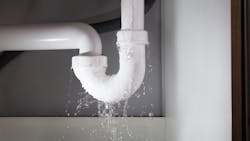Leak detection is a method used to detect the leak of materials from a pipeline and alert operators to these leak incidents. Water leak detection encompasses industrial, commercial, and residential leak detection.
The U.S. EPA notes that implementing leak detection and repair (LDAR) programs is crucial to mitigate the dangers associated with harmful emissions.
The 5 Components of Leak Detection
The five components of LDAR programs are: identifying components; leak definition; monitoring components; repairing components; and record-keeping.
According to EPA, sources of equipment leaks are pumps, valves, connectors, sampling connections, compressors, pressure relief devices and open-ended lines.
EPA uses Method 21 to locate and classify leaks.
EPA states: “Method 21 requires VOC emissions from regulated components to be measured in parts per million (ppm). A leak is detected when ever the measured concentration exceeds the threshold standard (i.e., leak definition) for the applicable regulation.”
Leak definitions vary by regulation, component type, service, and monitoring interval.
What Devices Are Used for Leak Detection?
There are two classes of leak detection: static leak detection systems and dynamic leak detection systems.
Static Leak Detection Systems
Static leak detection systems use sensors and data collectors placed within the water network and on valves. This system transmits data to the network management office periodically to identify leaks.
Static leak detection can detect a leak almost immediately and compared to dynamic leak detection are more prone to false alarms.
Dynamic Leak Detection Systems
Dynamic leak detection systems rely on moving leak detection devices to suspected leakage, and then confirm the leak by pinpointing it.
Dynamic leak detection systems are required to have information of a leak possibility, focusing more on mobilizing for investigation. These systems can pinpoint the exact location of a leak almost immediately.
Both static and dynamic leak detection systems can be used in conjunction: a static leak detection system to detect leaks in the first place and a dynamic leak detection system to pinpoint the leak exactly.
Examples of Leak Detection
Wastewater treatment plants use leak detection, as a leak in a plant can discharge contaminated fluids, which can result in hazardous consequences. Multiple leak detection systems are required at wastewater plants for safety purposes.
Leak detections systems installed in homes can monitor the flow of water through a pipeline, cutting off “the water flow to the entirety of the household by closing a valve within the leak detector. Leak detection systems are usually installed at the water’s point of entry into the home,” according to Fresh Water Systems.
According to the EPA, drinking water infrastructure in the U.S. can be a significant source of water loss through leaks.
Leaking underground storage tank for example, can impact the water quality of small drinking water systems. EPA reports that "a leaking underground storage tank fuel release from an UST that can contaminate surrounding soil, groundwater, or surface waters, and/or affect indoor air spaces."
Why is Leak Detection Important?
Without leak detection, threats to equipment and subsequent consequences may prove dangerous and costly. For instance, water leaks “can weaken the structural integrity of a building by causing rot,” according to the Industrial Quick Search Directory.
Water leaks are less expensive to manage than gas pipeline leaks, however, as gas pipeline leaks can be more hazardous.
What is Non-Revenue Water?
According to EPA, "non‐revenue water (NRW) is water that is not billed and no payment is received." Non-revenue water can be authorized or can be the result of real losses.
AWWA notes that NRW may also be defined as "the sum of Unbilled Authorized Consumption (water for firefighting, flushing, etc.) plus Apparent Losses (customer meter inaccuracies, unauthorized consumption and systematic data handling errors) plus Real Losses (system leakage and storage tank overflows)."
Water systems may use water loss control programs to understand and mitigate NRW. Water loss control programs, according to EPA, entail three major steps:
- The water audit, which identifies and quantifies water uses and losses from water systems;
- The intervention process, which addresses the water audit and sets controls to reduce or eliminate water losses; and
- The evaluation step, which uses performance indicators to note the progress and reach of the intervention process.
